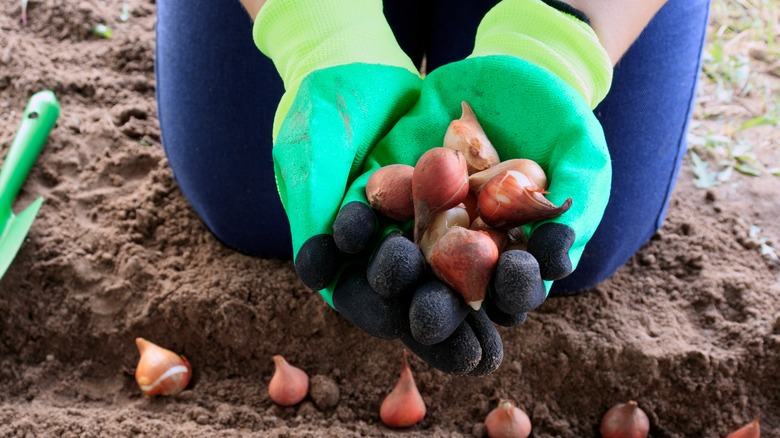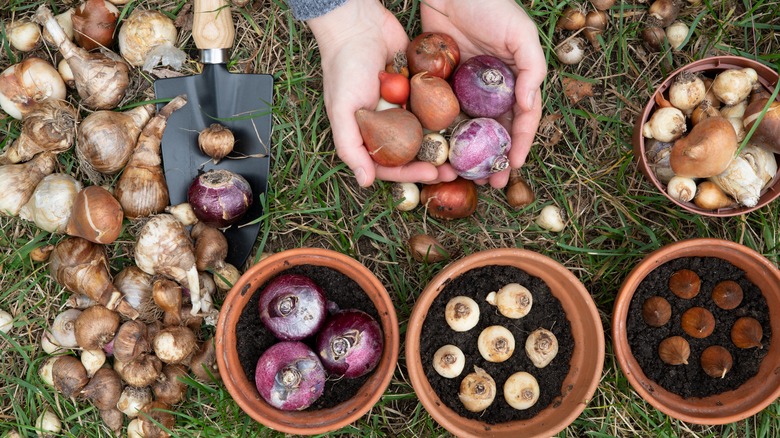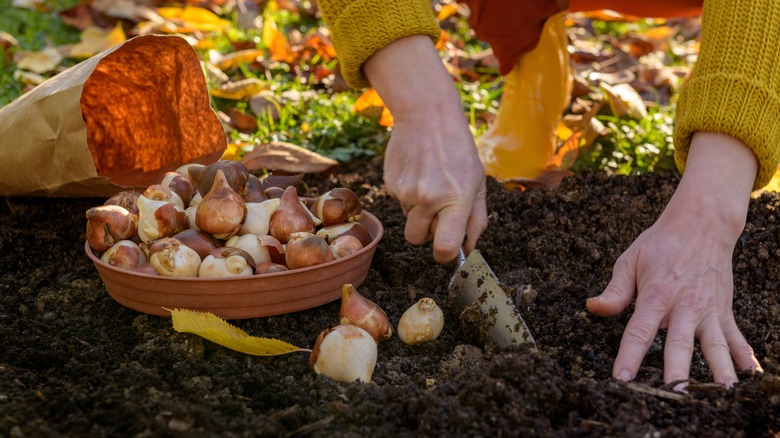Must-Know Bulb-Planting Tips From Our Expert Gardener
Spring has sprung, and with the return of sunshine and warmer temperatures comes a flood of photos featuring the best celebrity backyards, garden inspo, and more. Plenty of social media posts will leave you feeling mesmerized by colorful spring and summer blooms, but one scroll through Rhonda Kaiser's Instagram page is bound to make you wonder how she does it. Kaiser's biggest garden secret may be bulbs — and knowing the right techniques to grow them. In an exclusive interview with House Digest, the Founder and Content Creator behind Southern Home and Farm explained, "Bulbs are truly very easy to grow! Their life cycle can last for several months. I encourage you to try planting bulbs, mixed with other border plants, for a beautiful display in your garden."
Of course, while they might be beginner-friendly, bulbs still require some special attention to ensure they thrive in your garden and can be enjoyed for years to come. Kaiser shared expert tips and tricks for growing bulbs, the best places to plant them, and her favorites for the most gorgeous blooms.
Choose the right varieties and location
Before you pop your bulbs into the soil, there is some crucial prep work that must come first. In an exclusive interview with House Digest, Rhonda Kaiser explained that her first recommendation is to avoid fighting against nature. "Grow bulbs suitable for your specific climate," she advises, "Know your hardiness zone!" What are the bulbs you should be planting in your garden this spring for an Instagram-worthy garden like Kaiser's? Some of her personal favorite bulb plants include caladiums, crinum lilies, daffodils, narcissus, rain lilies, spider lilies, and tulips.
Once you've settled on the perfect plants, it's time to pick a place. "Location is key –- make certain your bulbs will receive at least a half day of sun," Kaiser says, adding, "Prepare your soil. Add organic matter to help reach a loamy consistency made up of sand, silt, and clay." Depending on what plants you choose and where you'll be growing your bulbs, plan ahead with the right number of bulbs to make a big visual impact in your garden. "For smaller bulbs, plant 12-15 bulbs per square foot to ensure a burst of color in that area," Kaiser recommends, "For larger bulbs, three to five per [square foot] offers a more dramatic effect."
Planting and regrowing your bulbs
Finding the proper depth to plant bulbs can be tricky, but Rhonda Kaiser shared a simple math trick in her exclusive interview with House Digest: "Most bulbs should be planted roughly three times the height of the bulb and two to three bulb widths apart. The exception are spring bulbs. Plant these with their tops showing slightly above ground." After planting your bulbs, Kaiser recommends finishing the area with a layer of mulch to protect the bulbs from the hot sun and improve drainage in the area.
One of the best benefits of bulbs is that you can also save your spring bulbs once the flowers have bloomed. "Most bulbs can be dug up and divided after they finish their life cycle, [but] do not dig up blooms when foliage is still present or green," warns Kaiser, "Wait until blooms are spent and foliage has turned yellow or brown. This means the bulb has entered a dormant phase and can be dug up." Most bulb plants are perennials, but not all bulbs will return naturally or with the same impact in the garden. "There are some varieties that are best composted and purchased anew every year, which can be a drawback due to cost-effectiveness," Kaiser explains, "[Paperwhites] are best treated as annuals, to be used only one time." Once you're in the groove with your bulb plants' bloom timing, Kaiser recommends giving succession planting a try: "This will ensure waves of blooms all season long!"


